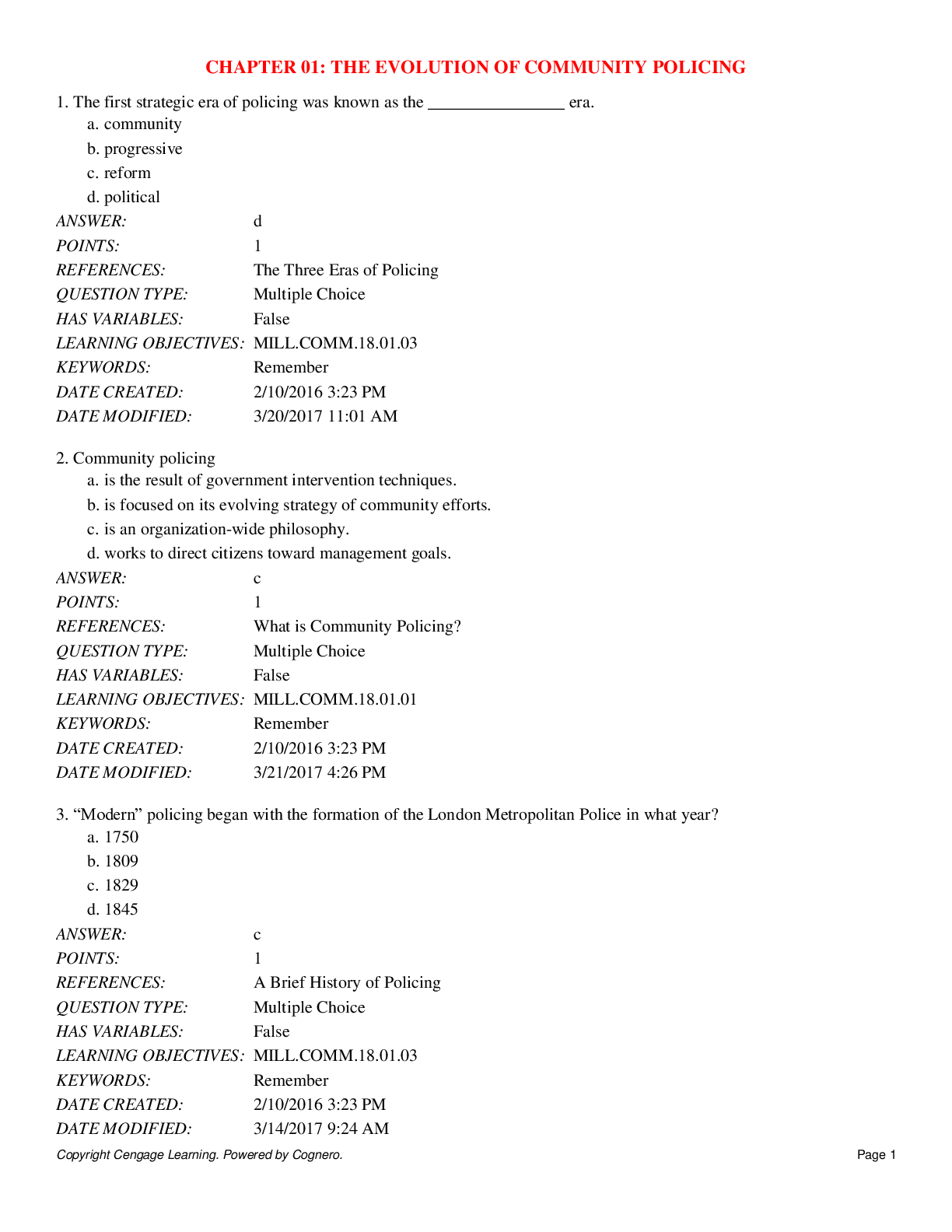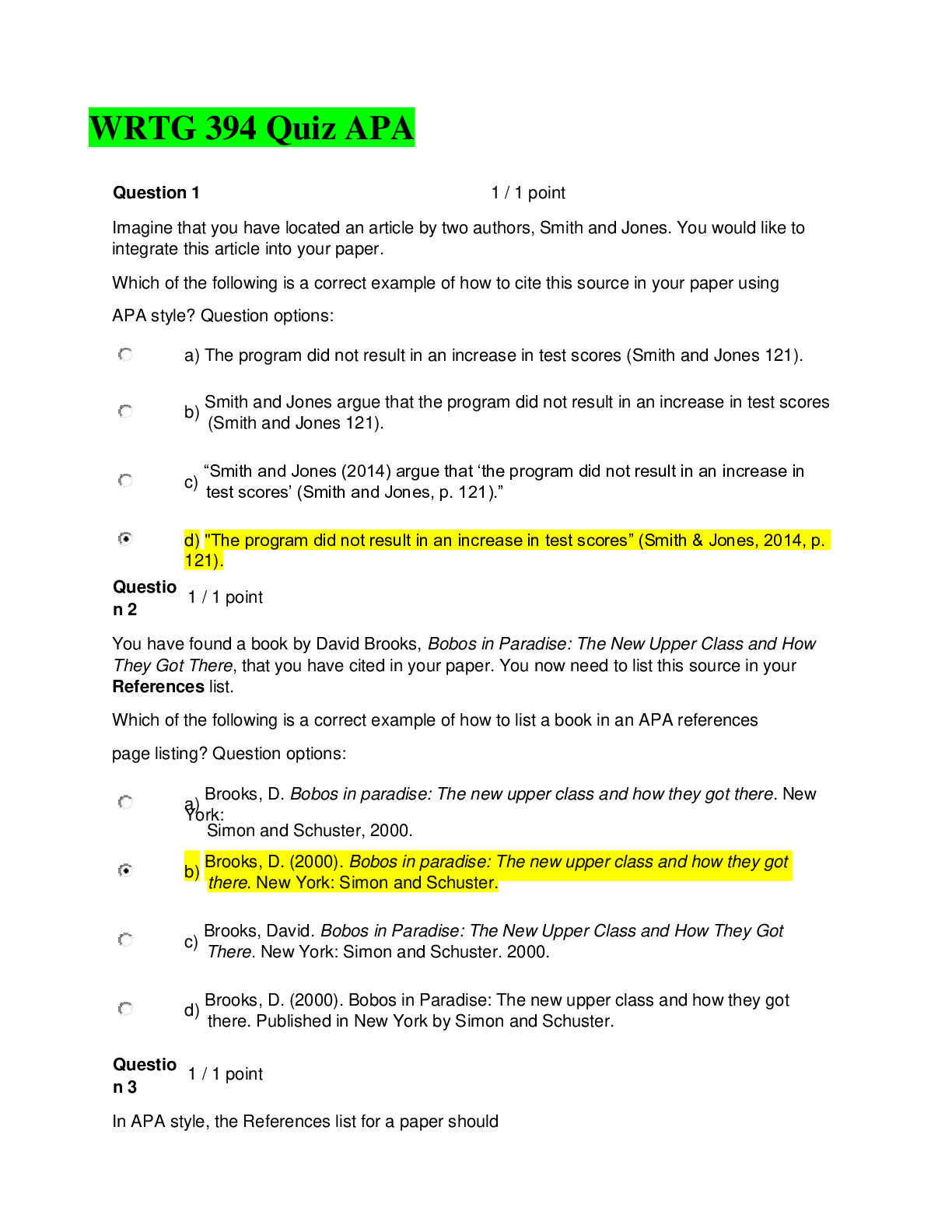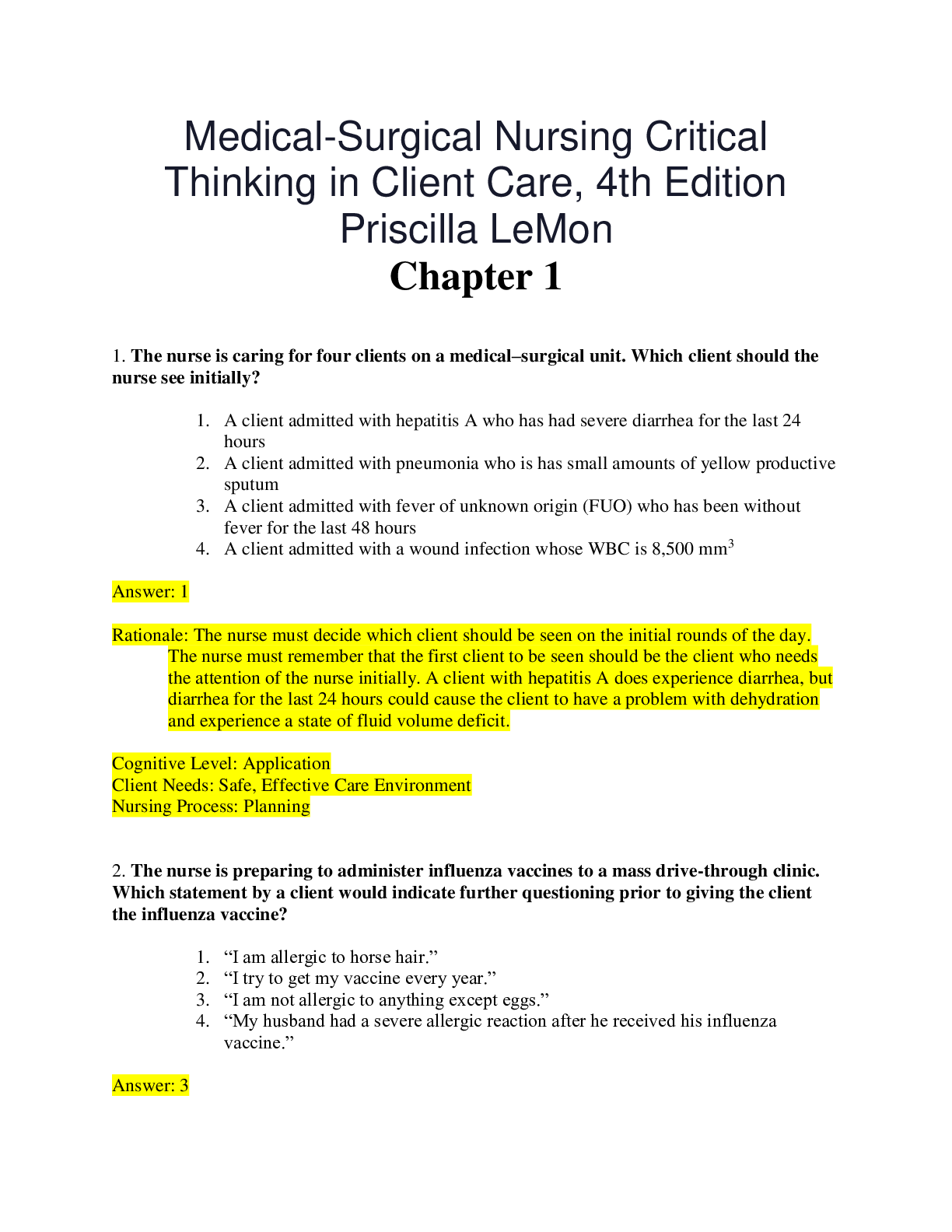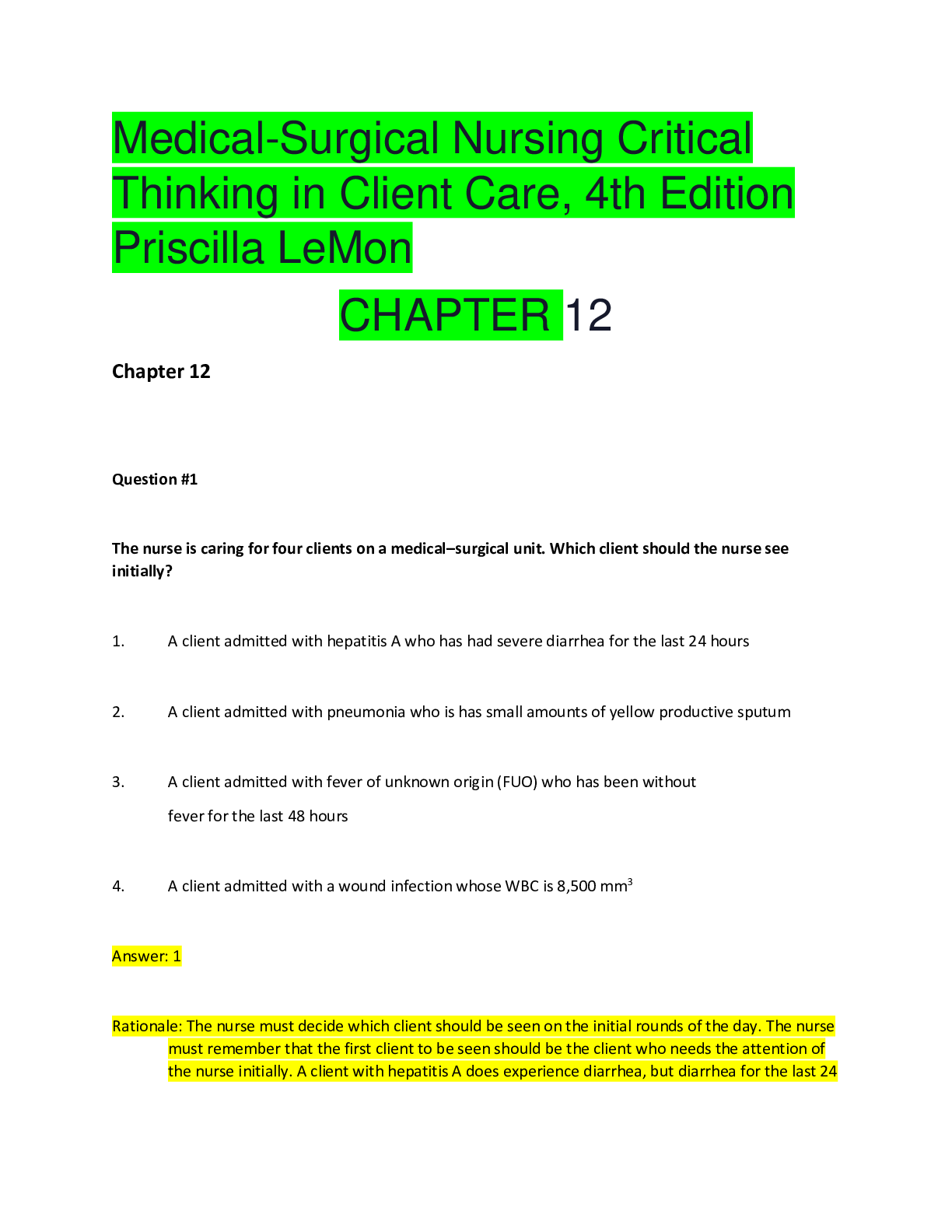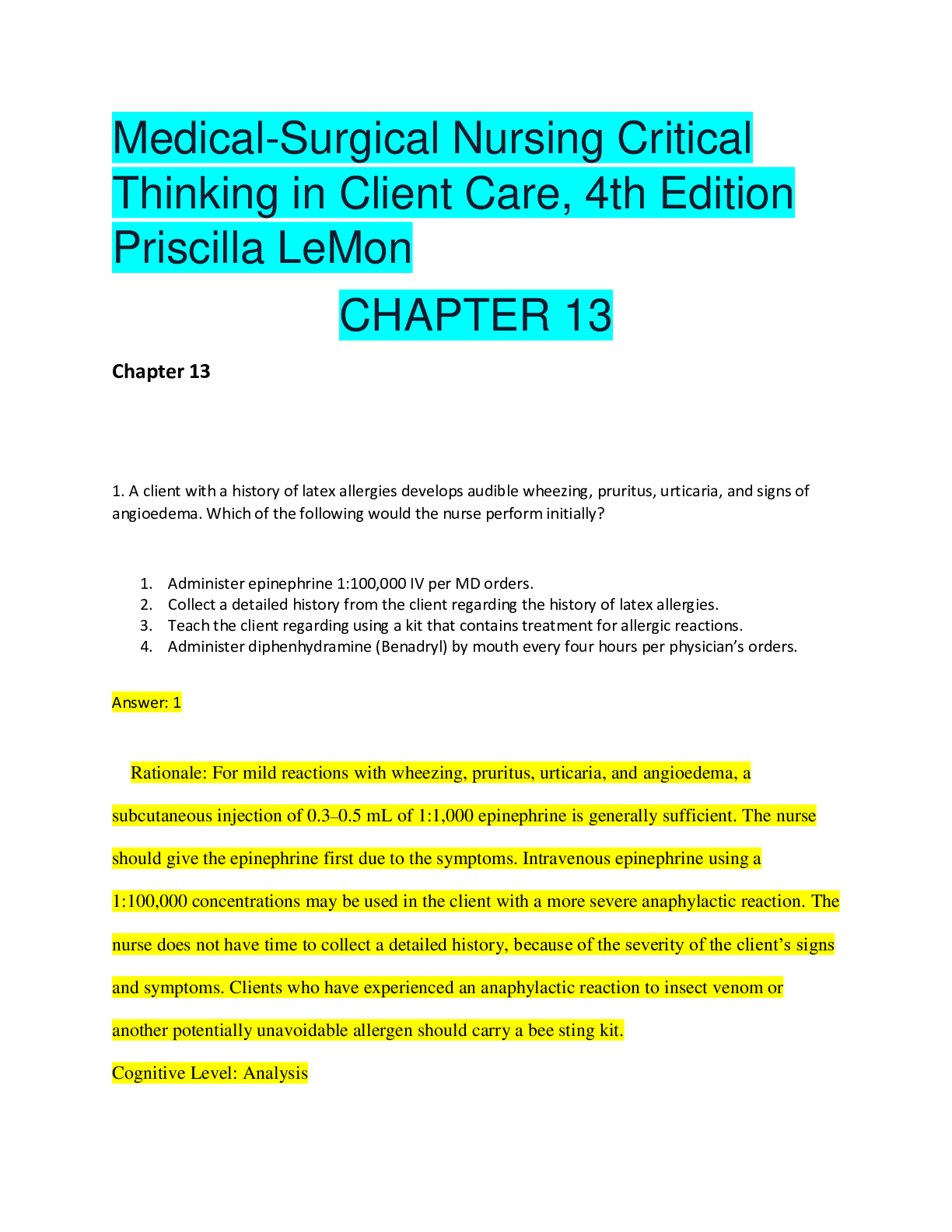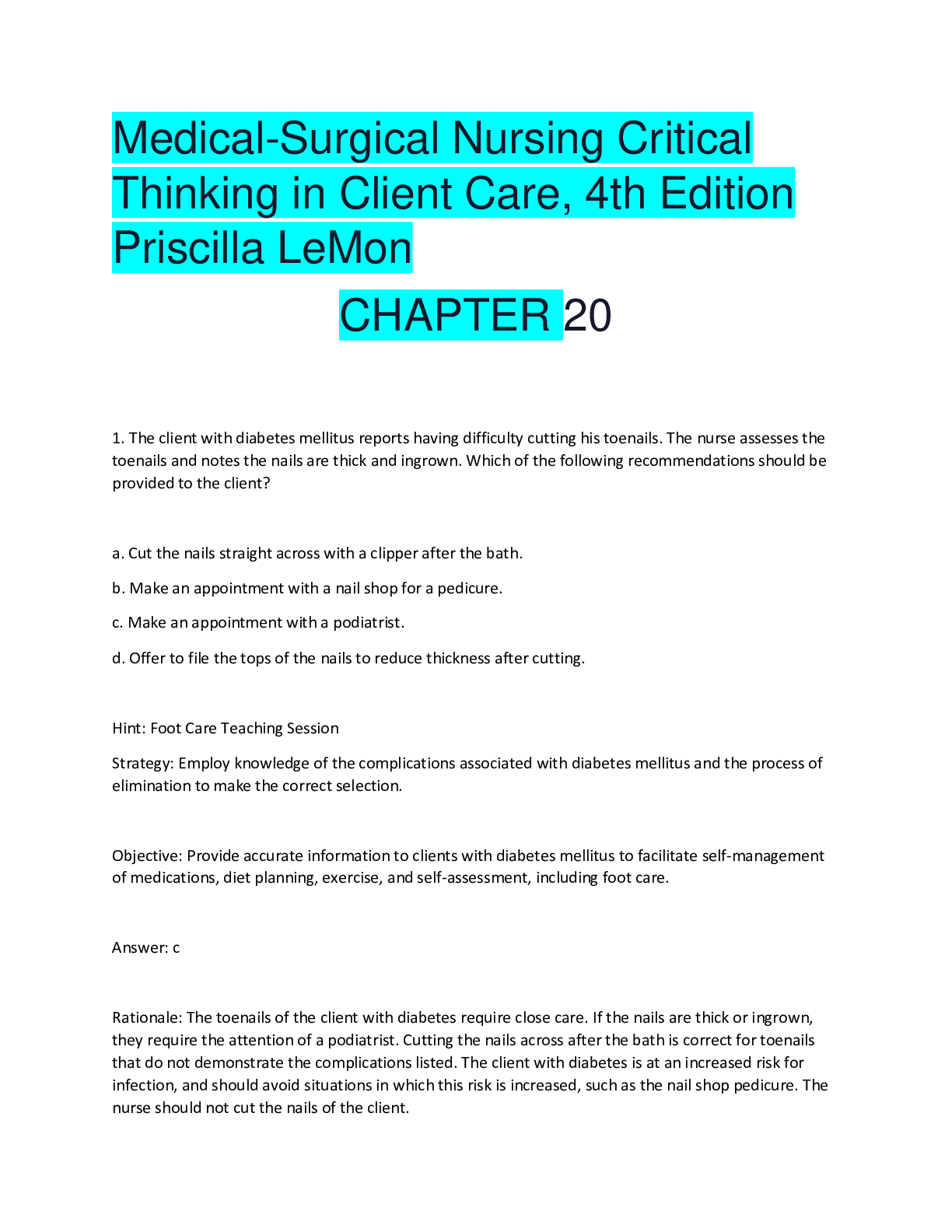*NURSING > QUESTIONS & ANSWERS > University Of Texas > Nursing > NURSING 224 Chapter 01: The History and Interviewing Process Test Ba (All)
University Of Texas > Nursing > NURSING 224 Chapter 01: The History and Interviewing Process Test Bank ( ALL CORRECT ANSWERS AND RATIONALE)
Document Content and Description Below
Chapter 01: The History and Interviewing Process Test Bank—Nursing MULTIPLE CHOICE 1. The primary objective of the initial encounter is to: a. define the advice and care for the... patient. b. establish the tone of a successful partnership. c. optimize your ability to help. d. tell the patient the limits of care. 2. If language is a barrier, the interpreter should be: a. a family member. b. a language board. c. a professional interpreter d. a staff person. 3. Mary Jane has brought in her 16-year-old son, Kyle. She states that he has been sleeping more and does not hang around his friends, and recently his girlfriend broke up with him. Your most immediate question is to ask Kyle: a. “Do you want to see a counselor today?” b. “Is your father out of jail yet?” c. “Are you taking any illegal drugs?” d. “Have you made plans to harm yourself?” 4. Ms. Yale is a 52-year-old patient who presents to the office for evaluation. During the interview, you say “Tell me what you do when you have knee pain.” The health care provider is asking information about: a. health promotion. b. the description and character of the complaint. c. the location and duration of the complaint. d. aggravating and relieving factors of the complaint. 5. Which question would be considered a “leading question?” a. “What do you think is causing your headaches?” b. “You don’t get headaches often, do you?” c. “On a scale of 1 to 10, how would you rate the severity of your headaches?” d. “At what time of the day are your headaches the most severe?” 6. To prevent personal appearance from becoming an obstacle in patient care, the health care professional should: a. wear a uniform. b. avoid wearing white. c. avoid extremes in dress. d. avoid wearing any jewelry. 7. Which action would best promote accurate translation and confidentiality when the caregiver does not speak the patient’s language? a. Ask a person unfamiliar with the patient to translate. b. Have a friend of the patient translate. c. Involve the family with the translation. d. Use a neighbor as translator. 8. When are open-ended questions generally most useful? a. During the initial part of the interview. b. After several closed-ended questions have been asked. c. While designing the genogram. d. During the review of systems. 9. Behaviors that diffuse anxiety during the interview include: a. avoiding wearing uniforms or laboratory coats. b. providing forthright answers to questions. c. providing all necessary information before the patient has to ask for it. d. completing the interview as quickly as possible. 10. Periods of silence during the interview can serve important purposes, such as: a. allowing the clinician to catch up on documentation. b. promoting calm. c. providing time for reflection. d. increasing the length of the visit. 11. Which technique is most likely to result in the patient’s understanding of questions? a. Use phrases that are commonly used by other patients in the area. b. Use the patient’s own terms if possible. c. Use the simplest language possible. d. Use proper medical and technical terminology. 12. Mr. Franklin is speaking with you, the health care provider, about his respiratory problem. Mr. Franklin says, “I’ve had this cough for 3 days, and it’s getting worse.” You reply, “Tell me more about your cough.” Mr. Franklin states, “I wish I could tell you more. That’s why I’m here. You tell me what’s wrong!” Which caregiver response would be most appropriate for enhancing communication? a. “After 3 days, you’re tired of coughing. Have you had a fever?” b. “I’d like to hear more about your experiences. Where were you born?” c. “I don’t know what’s wrong. You could have almost any disease.” d. “I’ll examine you and figure out later what the problem is.” 13. Mr. Miller is a 46-year-old patient who becomes restless during the history and says, “I don’t have time for all of this conversation. I’ve got to get back to work.” Your most appropriate response would be to: a. remember (acknowledge) his anger and proceed with the history and examination. b. ask another open-ended question and insist on an answer. c. ask questions about his anger and move closer to him. d. ignore his displeasure and become more assertive about getting answers. 14. When you are questioning a patient regarding alcohol intake, she tells you that she is “only a social drinker.” Which initial response is appropriate? a. “I’m glad that you are a responsible drinker.” b. “Do the other people in your household consume alcohol?” c. “What amount and what kind of alcohol do you drink in a week?” d. “If you only drink socially, you won’t need to worry about always having a designated driver.” 15. Ms. T is crying and states that her mother couldn’t possibly have a tumor. “No one else in the family has ever had cancer!” exclaims the daughter. The most appropriate response to Ms. T would be: a. “Has anyone explained hospice care to your mother?” b. “I’m so sorry that your mother was diagnosed with cancer.” c. “That is odd, since cancer usually runs in families.” d. “Why do you think that your mother’s tumor is cancerous?” 16. After you ask a patient about her family history, she says, “Tell me about your family now.” Which response is generally most appropriate? a. Ignore the patient’s comment and continue with the interview. b. Give a brief, undetailed answer. c. Ask the patient why she needs to know. d. Tell the patient that you do not discuss your family with patients. 17. A 36-year-old woman complains that she has had crushing chest pain for the past 2 days. She seems nervous as she speaks to you. An appropriate response is to: a. continue to collect information regarding the chief complaint in an unhurried manner. b. finish the interview as rapidly as possible. c. ask the patient to take a deep breath and calm down. d. ask the patient if she wants to wait until another day to talk to you. 18. Ms. A states, “My life is just too painful. It isn’t worth it.” She appears depressed. Which one of the following statements is the most appropriate caregiver response? a. “Try to think about the good things in life.” b. “What in life is causing you such pain?” c. “You can’t mean what you’re saying.” d. “If you think about it, nothing is worth getting this upset about.” 19. During an interview, tears appear in the patient’s eyes and his voice becomes shaky. Initially, you should: a. ask him if he would like some time alone. b. offer a tissue and let him know it is all right to cry. c. explain to the patient that you will be able to help him more if he can control his emotions. d. ask the patient what he is upset about. 20. During an interview, you have the impression that a patient may be considering suicide. Which action is essential? a. Ask whether the patient has considered self-harm. b. Avoid directly confronting the patient regarding your impression. c. Ask whether the patient would like to visit a psychiatrist. d. Record the impression in the patient’s chart and refer the patient for hospitalization. 21. During a history-taking session, Mr. B appears to be avoiding certain questions. He keeps looking out the window. What should the caregiver do? a. Ask direct questions and insist on a “yes” or “no” answer to each question. b. Continue to ask questions until Mr. B responds appropriately. c. Make a note to pursue sensitive issues later in the interview. d. Stop the interview until the patient is ready to cooperate. 22. You are collecting a history from an 11-year-old girl. Her mother is sitting next to her in the examination room. When collecting history from older children or adolescents, they should be: a. given the opportunity to be interviewed without the parent at some point during the interview. b. mailed a questionnaire in advance to avoid the need for them to talk. c. ignored while you address all questions to the parent. d. allowed to direct the flow of the interview. 23. Information that is needed during the initial interview of a pregnant woman includes all the following except: a. the gender that the woman hopes the baby will be. b. past medical history. c. health care practices. d. the woman’s remembering (knowledge) about pregnancy. 24. When communicating with older children and teenagers, you should be sensitive to their: a. desire for adult companionship. b. natural urge to communicate. c. need for verbal instructions. d. typical reluctance to talk. 25. When interviewing older adults, the examiner should: a. speak extremely loudly, because most older adults have significant hearing impairment. b. provide a written questionnaire in place of an interview. c. position himself or herself facing the patient. d. dim the lights to decrease anxiety. 26. When you suspect that your 81-year-old patient has short-term memory loss because he cannot remember what he had for breakfast, you should: a. order a neurology consult. b. stop all of his medications. c. validate the concern with his family or caregivers. d. dismiss the finding as a normal age-related change. 27. To what extent should the patient with a physical disability or emotional disorder be involved in providing health history information to the health professional? a. The patient should be present during information collection but should not be addressed directly. b. All information should be collected from past records and family members while the patient is in another room. c. The patient should be involved only when you sense that he or she may feel ignored. d. The patient should be fully involved to the limit of his or her ability. 28. A brief statement of the reason the patient is seeking health care is called the: a. medical history. b. chief complaint. c. assessment. d. diagnosis. 29. A pedigree diagram is drafted for the purpose of obtaining: a. sexual orientation and history. b. growth and developmental status. c. genetic and familial health problems. d. ethnic and cultural backgrounds. 30. When taking a history, you should: a. ask the patient to give you any information they can recall about their health. b. start the interview with the patient’s family history. c. use a chronologic and sequential framework. d. use a holistic and eclectic structure. 31. When questioning the patient regarding his or her sexual history, which question should be asked initially? a. “Do you have any particular sexual likes or dislikes?” b. “Do you have any worries or concerns regarding your sex life?” c. “How often do you have intercourse and with whom?” d. “Do you have any reason to think you may have been exposed to a sexually transmitted infection?” 32. A guideline for history taking is for caregivers to: a. ask direct questions before open-ended questions so that data move from simple to complex. b. ask for a complete history at once so that data are not forgotten between meetings. c. make notes sparingly so that the patient can be observed during the history taking. d. write detailed information as stated by patients so that their priorities are reflected. 33. Mr. D complains of a headache. During the history, he mentions his use of alcohol and illicit drugs. This information would most likely belong in the: a. chief complaint. b. past medical history. c. personal and social history. d. review of systems. 34. Direct questioning about domestic violence in the home should be: a. a routine component of history taking with female patients. b. avoided for fear of offending the woman’s partner. c. conducted only in cases in which there is a history of abuse. d. used only when the patient is obviously being victimized. 35. Mrs. G reports an increase in her alcohol intake over the past 5 years. To screen her for problem drinking, you would use the: a. CAGE questionnaire. b. PACES assessment. c. Miller Analogies Test. d. Glasgow Coma Scale. 36. A tool used to screen adolescents for alcoholism is the: a. CAGE. b. CRAFFT. c. PACES. d. HITS. 37. When you enter the examination room of a 3-year-old girl, you find her sitting on her father’s lap. She turns away from you when you greet her. Initially, your best response is to: a. leave the child sitting in the father’s lap while you talk to the father. b. ask the child to be seated on the examination table so that you can talk to her father. c. explain to the child that you will not hurt her and that she will have to trust you. d. ask the father to persuade the child to cooperate with you. 38. Tom is a 16-year-old diabetic who does not follow his diet. He enjoys his dirt bike and seems unconcerned about any consequences of his activities. Which factor is typical of adolescence and pertinent to Tom’s health? a. Attachment to parents b. High self-esteem c. Low peer support needs d. Propensity for risk taking 39. Pain is difficult to assess in older adults because: a. drugs act more rapidly with age. b. their language skills decline. c. they tend to exaggerate symptoms. d. sharp pain may be felt as a dull ache. 40. Mr. Mills is a 55-year-old patient who presents to the office for an initial visit for health promotion. A survey of mobility and activities of daily living (ADLs) is part of a(n): a. ethnic assessment. b. functional assessment. c. genetic examination. d. social history. 41. Constitutional symptoms in the ROS refer to: a. height, weight, and body mass index. b. fever, chills, fatigue, and malaise. c. hearing loss, tinnitus, and diplopia. d. rashes, skin turgor, and temperature. 42. JM has been seen in your clinic for 5 years. She presents today with signs and symptoms of acute sinusitis. The type of history that is warranted is a(n) _________ history. a. complete b. inventory c. problem or focused d. interim 43. Which of the following are connection types of communication? (Select all that apply.) a. Poor self image b. Good eye contact c. Avoiding being judgmental d. Ensuring good lighting e. Respecting silence f. Ensure confidentiality [Show More]
Last updated: 1 year ago
Preview 1 out of 14 pages
Instant download
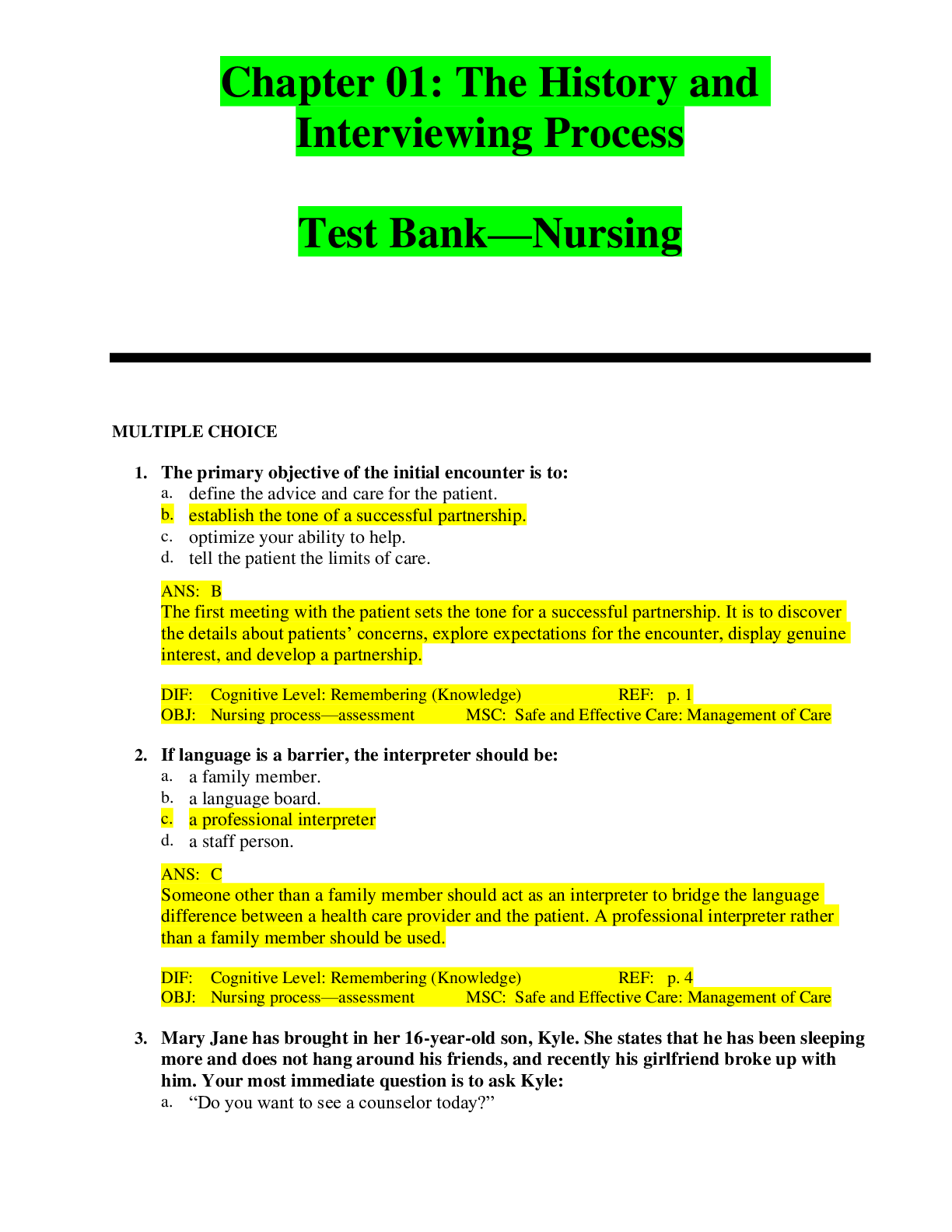
Buy this document to get the full access instantly
Instant Download Access after purchase
Add to cartInstant download
Reviews( 0 )
Document information
Connected school, study & course
About the document
Uploaded On
Apr 22, 2020
Number of pages
14
Written in
Additional information
This document has been written for:
Uploaded
Apr 22, 2020
Downloads
0
Views
50













